NO MOCKING Here, Just EATING and ENJOYING!
In his play “Henry the V,” William Shakespeare said, “If you can mock a leek, you can eat a leek!” I didn’t know any leek-mocking was going on, but I do know there are some very good reasons why you want to add leeks to your weekly diet, if you aren’t already.
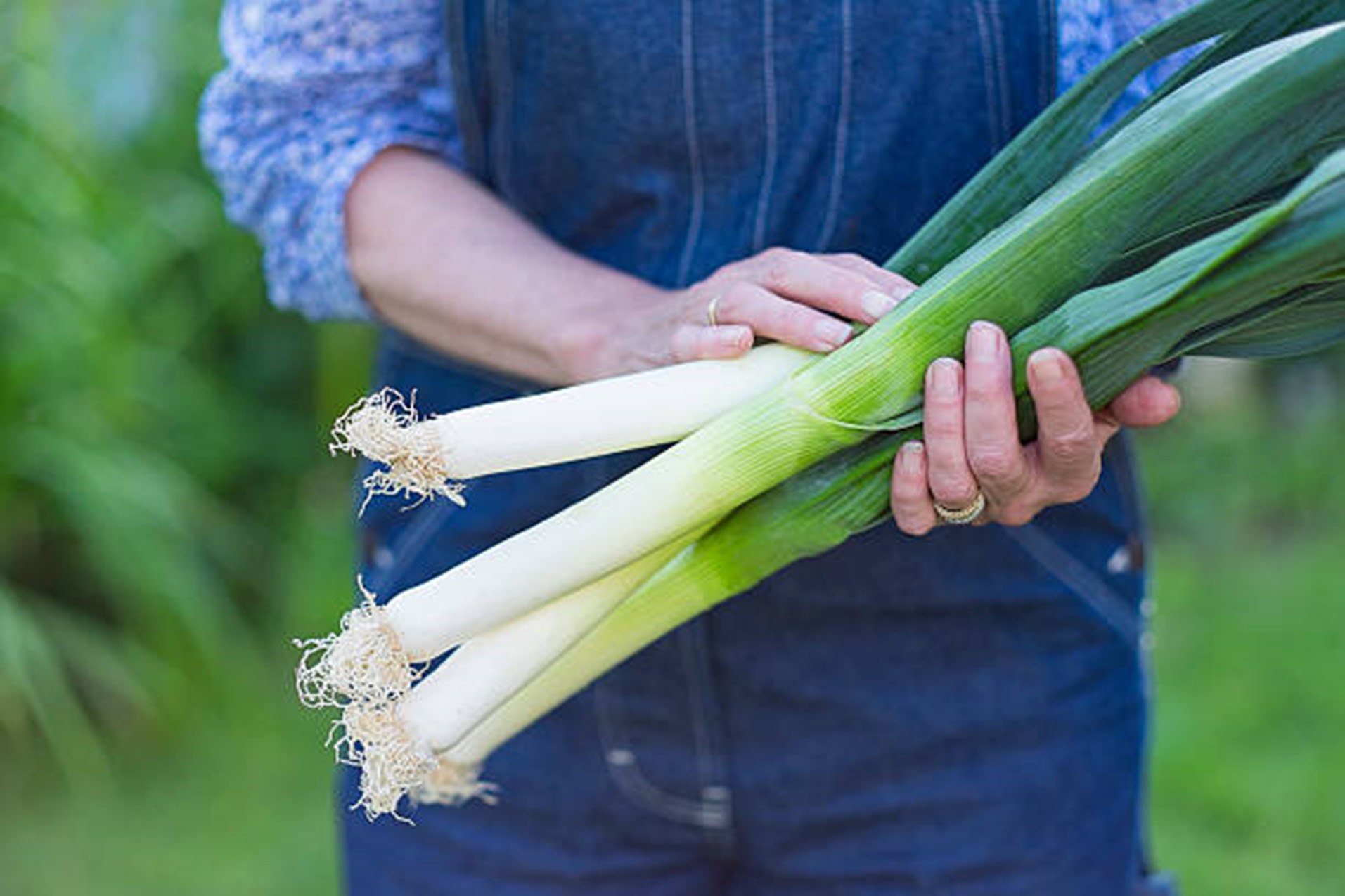
First of all, they’re an excellent source of antioxidants like vitamins C, K and beta-carotene—meaning they have powerful anti-inflammatory and anti-aging benefits. And they’re loaded with carotenoids, including zeaxanthin and lutein which protect the eyes (they reduce risk of cataracts and age-related macular degeneration).
Leeks are also rich in potassium, so they’re our blood pressure’s friend (move over, bananas!). The latest food science research also shows they improve digestion, reduce the risk of cancer, help with weight loss and maintenance, help to treat type 2 diabetes, and strengthen our bones.
Leeks are alliums, so they’re related to garlic, chives, shallots, and onions. Tasting them, you can tell. They have a sweet, oniony flavor that adds depth to soups, stews, and pastas without being obnoxiously oniony (you onion-haters know what I mean).
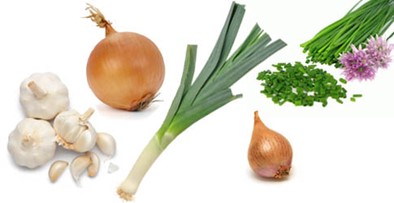
Because they’re milder than most other alliums, you can enjoy them on their own. They make a really good side dish when roasted or grilled (just be sure to use peak-season, ultra fresh leeks for this purpose).
“Peak season” for leeks? Spring is best, and in some areas, even fall. Leeks will be one of the first spring crops to show up at our local farmers’ markets. Can’t wait!
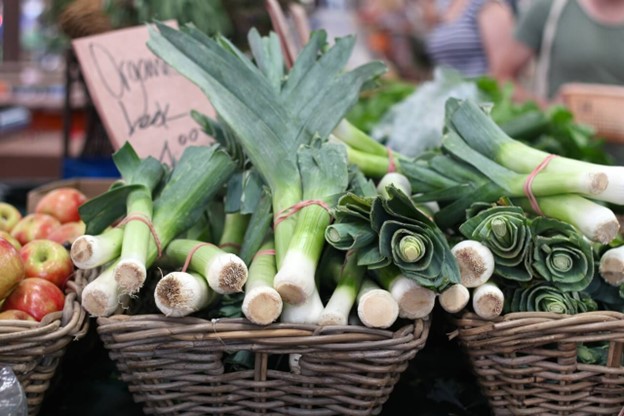
There are a couple things to know if you decide to mess around with leeks. How you cut then will vary based on how you cook them. The method used most often for sauteeing (think soups, pasta, or risotto) is to
If you find dirt between the vegetable’s layers, that’s normal. They typically show up with dirt and sand, due to how they’re grown. Thus, rinsing them well is an important step to your cutting process.
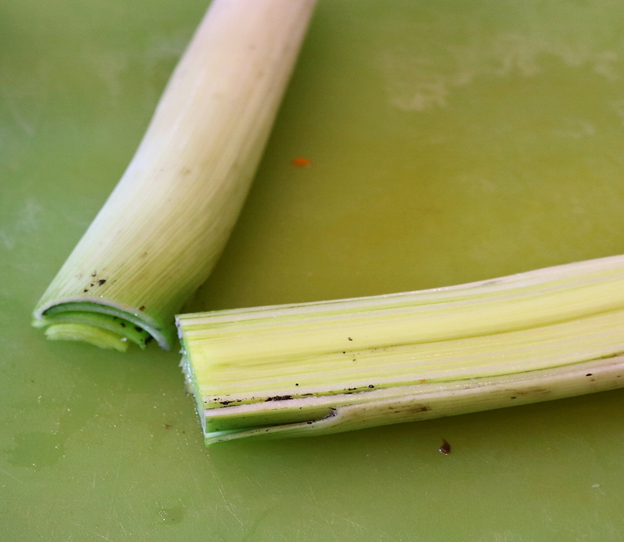
Once cut into thin slices, place them in salad spinner basket; place basket in bowl of cool water and swish the slices around for a minute or two. Let sit for another minute, then pour off water and spin leeks dry. I’ve tried rinsing them under cool water in a colander, but giving them a soak and using a salad spinner seems to be more effective in removing dirt and debris.
When the chopped leeks are clean, use a paper towel or kitchen towel to blot them dry before you start cooking. To sauté them, follow the cutting method described above, and warm a generous amount of olive oil in a large skillet over medium heat. Add the leeks and cook, stirring occasionally, until they soften, about 5 minutes.
I’ll close with a favorite recipe from www.loveandlemons.com, by Jeanine and Jack. This is scrumptious (I think especially because of the featured leeks), and so easy to make.
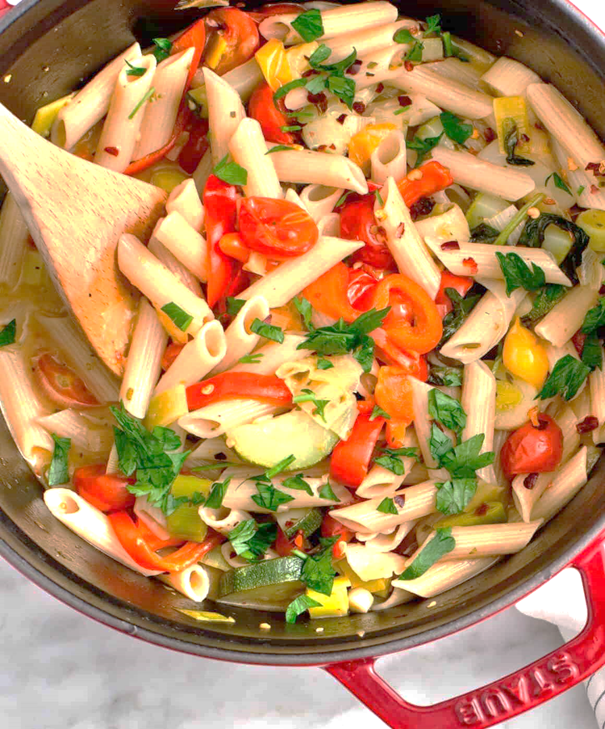
6 ounces penne pasta
1 1/2 cups sliced cherry tomatoes
1 1/2 cups thinly sliced leeks
1 cup zucchini sliced into ¼-inch thick half moons
1/2 cup thinly sliced red bell peppers
3 cloves garlic (small) minced
2 tablespoons extra virgin olive oil
2 tablespoons fresh lemon juice plus 1 teaspoon zest
1 teaspoon dried oregano
1 teaspoon sea salt
1/2 teaspoon red pepper flakes
1 sprig fresh basil
2 1/4 cups water
TOP WITH
chopped fresh parsley
toasted pine nuts
grated Parmesan cheese and/or Hemp Seed Topping, optional
HEMP SEED TOPPING
1/2 cup hemp seeds
2 tablespoons nutritional yeast
2 tablespoons raw sunflower seeds
1 pinch sea salt
Directions:
Add Recipe to Cook'n

First of all, they’re an excellent source of antioxidants like vitamins C, K and beta-carotene—meaning they have powerful anti-inflammatory and anti-aging benefits. And they’re loaded with carotenoids, including zeaxanthin and lutein which protect the eyes (they reduce risk of cataracts and age-related macular degeneration).
Leeks are also rich in potassium, so they’re our blood pressure’s friend (move over, bananas!). The latest food science research also shows they improve digestion, reduce the risk of cancer, help with weight loss and maintenance, help to treat type 2 diabetes, and strengthen our bones.
Leeks are alliums, so they’re related to garlic, chives, shallots, and onions. Tasting them, you can tell. They have a sweet, oniony flavor that adds depth to soups, stews, and pastas without being obnoxiously oniony (you onion-haters know what I mean).

Because they’re milder than most other alliums, you can enjoy them on their own. They make a really good side dish when roasted or grilled (just be sure to use peak-season, ultra fresh leeks for this purpose).
“Peak season” for leeks? Spring is best, and in some areas, even fall. Leeks will be one of the first spring crops to show up at our local farmers’ markets. Can’t wait!

There are a couple things to know if you decide to mess around with leeks. How you cut then will vary based on how you cook them. The method used most often for sauteeing (think soups, pasta, or risotto) is to
- first remove the stringy roots and tough upper tough green leaves; because these add great flavor to homemade soup stock, you’ll want to store them in an airtight bag in the freezer until ready for use
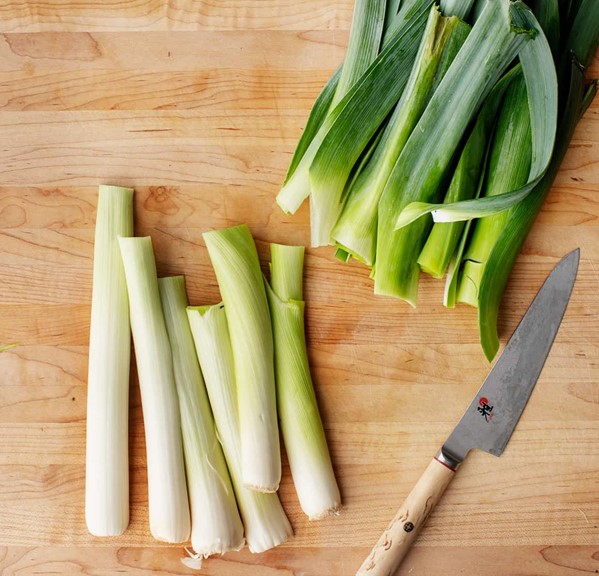
- then slice the remaining white-light green cylinders in half lengthwise
- continue chopping the white and light green parts. Lay them cut-side-down on your cutting board, and cut them into thin half-moons.
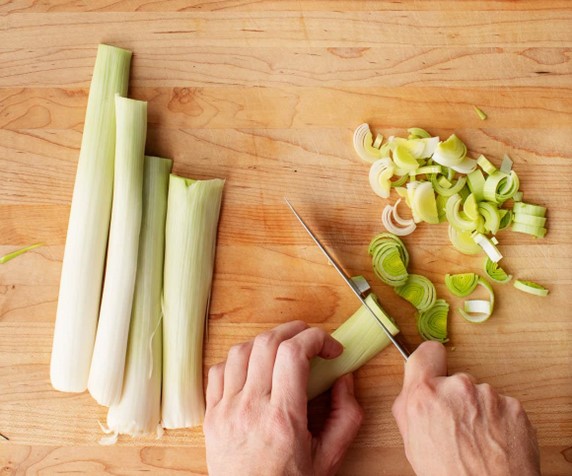
If you find dirt between the vegetable’s layers, that’s normal. They typically show up with dirt and sand, due to how they’re grown. Thus, rinsing them well is an important step to your cutting process.

Once cut into thin slices, place them in salad spinner basket; place basket in bowl of cool water and swish the slices around for a minute or two. Let sit for another minute, then pour off water and spin leeks dry. I’ve tried rinsing them under cool water in a colander, but giving them a soak and using a salad spinner seems to be more effective in removing dirt and debris.
When the chopped leeks are clean, use a paper towel or kitchen towel to blot them dry before you start cooking. To sauté them, follow the cutting method described above, and warm a generous amount of olive oil in a large skillet over medium heat. Add the leeks and cook, stirring occasionally, until they soften, about 5 minutes.
I’ll close with a favorite recipe from www.loveandlemons.com, by Jeanine and Jack. This is scrumptious (I think especially because of the featured leeks), and so easy to make.

One Pot Vegetable Penne Pasta
Yield: 2 or 3 large servings
Ingredients:
6 ounces penne pasta
1 1/2 cups sliced cherry tomatoes
1 1/2 cups thinly sliced leeks
1 cup zucchini sliced into ¼-inch thick half moons
1/2 cup thinly sliced red bell peppers
3 cloves garlic (small) minced
2 tablespoons extra virgin olive oil
2 tablespoons fresh lemon juice plus 1 teaspoon zest
1 teaspoon dried oregano
1 teaspoon sea salt
1/2 teaspoon red pepper flakes
1 sprig fresh basil
2 1/4 cups water
TOP WITH
chopped fresh parsley
toasted pine nuts
grated Parmesan cheese and/or Hemp Seed Topping, optional
HEMP SEED TOPPING
1/2 cup hemp seeds
2 tablespoons nutritional yeast
2 tablespoons raw sunflower seeds
1 pinch sea salt
Directions:
1. In a large pot, combine the pasta, tomatoes, leeks, zucchini, bell pepper, garlic, olive oil, lemon juice and zest, oregano, salt, red pepper flakes and basil. Add the water and stir.
2. Bring to a boil, cover, and boil for 8 minutes. Give it a stir around the 5-minute mark to make sure nothing is sticking to the bottom of the pan and put the cover back on.
3. At 8 minutes, test the pasta for doneness.
4. Remove the pot from the heat, stir, and let it sit for about 2 minutes to allow the sauce to thicken.
5. If using, make the Hemp Seed Topping: In a food processor, combine the hemp seeds, nutritional yeast, sunflower seeds and salt and pulse to combine.
6. Serve with the chopped parsley, toasted pine nuts and parmesan cheese or Hemp Seed Topping, if using.
2. Bring to a boil, cover, and boil for 8 minutes. Give it a stir around the 5-minute mark to make sure nothing is sticking to the bottom of the pan and put the cover back on.
3. At 8 minutes, test the pasta for doneness.
4. Remove the pot from the heat, stir, and let it sit for about 2 minutes to allow the sauce to thicken.
5. If using, make the Hemp Seed Topping: In a food processor, combine the hemp seeds, nutritional yeast, sunflower seeds and salt and pulse to combine.
6. Serve with the chopped parsley, toasted pine nuts and parmesan cheese or Hemp Seed Topping, if using.
Recipe formatted with the Cook'n Recipe Software from DVO Enterprises.
 Alice Osborne
Alice Osborne
Weekly Newsletter Contributor since 2006
Email the author! alice@dvo.com
